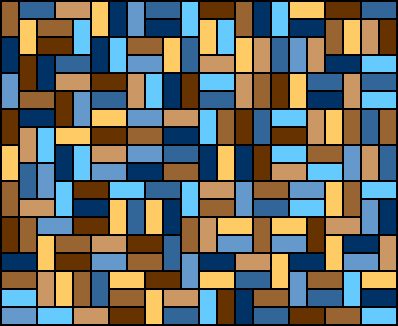In Local Statistics of Lattice Dimers we study a nice familiar object, domino tilings in the plane extending out to infinity.

His paper is going to discuss the frequency of various "motifs" in tiligns of infinite dimer regions and I am hoping to verify all such frequences lie in $\mathbb{Q}[\tfrac{1}{\pi}]$.
However, I am thrown off by the following phrase:
It is known that the translation-action of $\mathbb{Z}^2$ on dominos or lozenges is topologically mixing
I didn't even know where was a translation action on domino tilings. Kenyon proceeds to quantify this "mixing" as
$$ \mu(U_{T_1}\cap U_{v+T_2}) = \mu(U_{T_1})\,\mu(U_{v+T_2}) + O(\tfrac{1}{|v^2|}) $$
Apparently the translation $T_v: \mathbb{Z}^2 \to \mathbb{Z}^2$ induce a translation on the set of infinite dimer tilings on the plane $T_v: X \to X$.
This mixing result says any two motifs $T_1, T_2$ are relatively independent of each other. Then a tiling is expected to have a motif $T_1$ in one area with probability $\mu(U_{T_1})$ and $T_2$ with probability $\mu(U_{T_2})$. The odds of having both is close to $\mu(U_{T_1})\mu(U_{T_2}) $
Intuitively, I would have just embedded both regions $T_1$ and $T_2$ in a tilings of the square and computed the frequences of both motifs $T_1$ and $v + T_2$ occurring in random tilings as the size of the square got large.
However, the more they try to get precise, the more confused I get.
- Translation is not mixing in the plane, and yet it is mixing on the space of domino tilings. How does that make sense?
- What was the important of identifying the unique measure $\mu$ of maximal entropy? and showing $\mu$ was the same as that of uniform random tiling for large squares with entropy ? $$ H = \frac{1}{k^2} \log |\#\{ \text{ tilings of }\square_{k \times k}\}|$$
